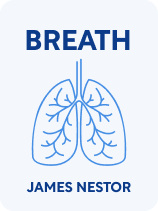

This article is an excerpt from the Shortform book guide to "Breath" by James Nestor. Shortform has the world's best summaries and analyses of books you should be reading.
Like this article? Sign up for a free trial here.
Is nose breathing better than mouth breathing? How can you habituate yourself to breathe through your nose?
Your nose and sinus cavity are specifically designed to process air in ways your mouth can’t. Breathing through the nose strengthens your airways, regulates your metabolism, and even has a positive effect on your brain.
Here’s why you should try to breathe through the nose instead of the mouth.
Breathe Through Your Nose
When you begin to breathe through the nose instead of the mouth, the tissues in your sinus and the back of your throat will cease to atrophy from lack of use. As with muscles, the sinus and throat will grow stronger with exercise; they will soon function better and allow for a healthier airflow. Meanwhile, the nose’s cilia (fine hairs) and turbinates (boney structures) heat and clean the air you inhale so your lungs can extract more oxygen from it. The sinus also releases nitric oxide into the body, which widens blood vessels and increases circulation. In the author’s self-experiment, when he unplugged his nostrils, in only a few days his blood pressure went down and his blood’s carbon dioxide returned to normal.
(Shortform note: The anatomy of the nose and sinus cavity is even more complex than Nestor’s description indicates. It’s an ornate structure of cartilage, bone, skin, fatty tissue, three pairs of turbinates, and four pairs of sinuses. In addition to the infections and congestion Nestor warns of, it’s also vulnerable to nosebleeds, cancer, injuries, and genetic disorders. While scientists confirm Nestor’s assertion that nitric oxide is crucial to supplying oxygen to the body, it’s still not fully understood how or where it’s produced in the nasal cavity, though current evidence points to the paranasal sinuses, which were long considered to be unimportant organs.)
But it’s not just the act of breathing that does this. Nestor writes that there is a nasal cycle in which the right and left nostril alternate to control body temperature, blood pressure, and brain chemicals. (If you notice from time to time that one nostril congests while the other stays open, and then they mysteriously switch later on, this is the nasal cycle in action.) When breathing through your right nostril, your pulse, blood pressure, body temperature, and cortisol levels increase. Breathing through the left nostril has the opposite effect, and cycling between the two maintains your body’s balance. Breathing through your mouth, on the other hand, disengages the nasal cycle completely, depriving you of its body-regulating benefits.
Furthermore, the nasal cycle helps regulate the brain. The right nostril is connected to the sympathetic nervous system, raising alertness and logical thinking. Likewise, the left nostril is linked to the parasympathetic nervous system, affecting creativity and abstract thought. By switching the breath back and forth between the two, the body maintains mental equilibrium between states of relaxation and alertness.
| The Nasal Cycle It’s not accurate to describe the nasal cycle as “breathing through one nostril at a time,” when in fact the distribution is closer to 75% through one and 25% through the other at any given period, nor is it true that everyone has a nasal cycle at all. It’s only observed in 70-80% of the population, and in only half of those is the cycle truly periodic. The nasal cycle is present in all mammals, not just humans, and is powered by asymmetrical blood flow to the sinuses. Studies confirm a loose correlation between the dominant nostril and the opposite hemisphere of the brain, but other research suggests that the cycle’s function in the body is to allow cells on either side of the nasal passage to recharge while alternating between air-conditioning and mucus-clearing processes. |

———End of Preview———
Like what you just read? Read the rest of the world's best book summary and analysis of James Nestor's "Breath" at Shortform.
Here's what you'll find in our full Breath summary:
- Why you're probably breathing wrong
- The benefits of learning how to breathe properly
- The potentially dangerous side effects of mouthbreathing






